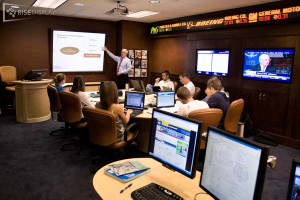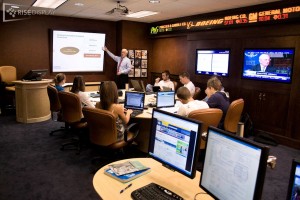Investing money may seem like an activity reserved for business professionals, but over the past fifteen years, Houghton College students have participated in this pursuit. Last year, Houghton College’s Investment Group outperformed professional investors by a wide margin, according to member Joseph Gilligan ‘17. This dynamic group uses their shared perspective as students to take risks and gauge the market in unconventional ways. The skills that they hone in the process make them better candidates for jobs and internships.

When the Investment Group was endowed by Houghton College in 2001, a select group of business students were given $20,000 to invest. Today, these funds have been increased to $350,000. To be eligible for the Investment Group, a student must hold a 3.5 grade point average and have taken several finance courses. Only juniors and seniors are accepted, with two exceptions in the history of the club. The first is Gilligan, who joined his freshman year. The second is Tyler Stetson ’20, who joined this semester. Both Gilligan and Stetson said they began investing in middle school. The group currently has 10 members, according to member Ryan Buckley ‘17.
To invest, the group must reach consensus. Their advisor, assistant professor of business administration Pil Joon Kim, has the ability to veto stock decisions made by students if he believes it is a poor decision, but this veto power has never been used. According to Jesse Toth ’17, that consensus is a very important part of the group dynamic. He said that senior members Buckley and Gilligan have differing views: “They present two sides of the argument, and you’re weighing the options. I’ve learned so much from watching them just going at it,” he said.
Buckley said his approach is more specific to companies, or microeconomics. Gilligan, meanwhile, prefers to focus on macroeconomics, or the big picture of economic trends. “Through our different approaches on investing, I always am confident in a stock choice we both agree on,” Gilligan said.
The group members attributed some of their success to their perspective as students. “Professionals wait until the hard numbers come in, but we look at the media and the big picture to predict where the best returns will be,” Buckley said. He gave two examples of stocks the group invested in recently that proved to be wise investments: Netflix and Disney. When Netflix’s monthly price went up, many people stopped investing in the company, Buckley said. However, as students, the members of the Investment Group knew that a few more dollars a month is a small price to pay for the ability to binge-watch shows. “People aren’t going to give up their Netflix,” Gilligan said.
The investment in Disney was also a choice that professional investors would not have made, because it was based on expectations rather than numbers. “We knew that Disney was opening a new park in China and lots of people would want to go to that. We also knew that Disney owned the Star Wars franchise and a new movie was about to come out,” Buckley said. These unconventional methods have helped them beat not only the stock market return, but top hedge funds, according to Gilligan.
In the past, the Investment Group has had many opportunities open up to them due to their success, Gilligan said. “Two years ago, we were invited to Morgan Stanley, Credit Suisse, and Archegos Capital. It was a great experience where we learned great trading techniques, gained a better sense of the nature of the work, and provided us with a great opportunity to network with top investment banks and hedge funds,” he said. He also said last year Hedge Fund Manager Bill Hwang visited the group. “It was a great experience to present our stock techniques to a person I have read about in books,” Gilligan said.
This semester, the Investment Group is on the cusp of discovering for themselves and implementing a brand new model. Their advisor has worked out a yet-unpublicized model of investing to predict where the price of a stock is going, and Toth said that Kim has asked the Investment Group figure it out for themselves using Excel. “Having a model that no one has used before,that’s huge. We can take advantage of that,” Toth said.
This semester, the Investment Group will have the opportunity to participate in a stock market competition at Temple University. The team will consist of Buckley, Gilligan, and Stetson.
“We will be competing against all of the best schools in the nation, but I am confident that with our investing strategy that we will win,” said Gilligan.

